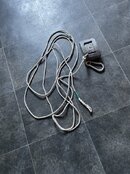flymolo
Contributor
Most anchor lines are of braided construction and many have a red/colored tracer fiber in them too. The line itself give you plenty of visual cues if you are moderately close to it and paying attention. No need to add colored clothes pins etc. If it's a fixed mooring the boat tied into that has even more visual cues from the inevitable marine growth.
I would practice more in controlled situations before accumulating an actual open water deco obligation. There's always the chance you'll not be able to come up the anchor/mooring line. If you're already anxious about open water ascents with an anchor/mooring line reference imagine having that taken away and you'll be really stressed.
Using an SMB tied off to the bottom at a benign site is a good way to practice. The thin #24 line gives you few visual cues, basically just the tiny knot every 10ft. If you can nail practice ascents with a tiny fixed line then graduate to retrieving the SMB as you go. Eventually you'll be at the point where a fat anchor line in your face feels like cheating - that's when you're confident enough to be doing open water deco and its fun (or fun enough) to not be a stress.
I find it hard to use a plain anchor line as a reference so i like to hang my strobe from it at the target depth, and then get back up off the line and stare at the strobe while i zen out for a little while. if the line has some features like a tracer or a bit of fray or something i'm sure that would help too, but a perfectly uniform line just doesn't work for me personally.





